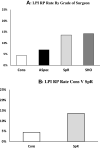Surgical Grade and Repeat Laser Peripheral Iridotomy Procedures with Risk Stratification and Educational Considerations
- PMID: 33335384
- PMCID: PMC7737541
- DOI: 10.2147/OPTH.S283370
Surgical Grade and Repeat Laser Peripheral Iridotomy Procedures with Risk Stratification and Educational Considerations
Abstract
Background/aims: Peripheral laser iridotomy (PLI) is a commonly performed procedure. While effective, repeat procedures (RPs) may be required for a variety of causes. We report the causes and rate of RP PLI and whether surgical grade is a risk factor.
Methods: Two years of retrospective data from 282 patients who had undergone PLI at a single UK ophthalmology department were retrieved using an electronic medical record system (Medisoft, Leeds, UK).
Results: A total of 253 patients underwent analysis with 20 requiring RPs. Our data identified a correlation between experience of the operating surgeon and an increase in RP rate, with statistical significance (p=0.036) observed between consultants and registrars. No other statistically significant risk factors were identified from our study. Prescriber preference for iopidine was observed. From our findings and the current literature, prognostic factors that appear to influence RP rate include surgical grade, patient compliance, Asian ethnicity, and anticoagulation.
Conclusion: RP rate increases in PLI when a junior surgeon is performing the procedure, and thus cases with established prognostic factors for RPs should have senior input. Formal and standardized YAG-laser training should be implemented alongside risk stratification of patients to improve both trainee education and patient care.
Keywords: education; glaucoma; iris; laser treatment.
© 2020 Riley et al.
Conflict of interest statement
The authors report no conflicts of interest in this work.
Figures
Similar articles
-
Laser peripheral iridoplasty for chronic angle closure.Cochrane Database Syst Rev. 2021 Mar 23;3(3):CD006746. doi: 10.1002/14651858.CD006746.pub4. Cochrane Database Syst Rev. 2021. PMID: 33755197 Free PMC article.
-
[Acute angle-closure glaucoma despite previous Nd:YAG laser iridotomy: a report on 13 cases].Ophthalmologe. 2003 Oct;100(10):832-5. doi: 10.1007/s00347-003-0805-3. Ophthalmologe. 2003. PMID: 14618357 German.
-
The long-term effect of Nd:YAG laser iridotomy on intraocular pressure in Taiwanese eyes with primary angle-closure glaucoma.J Chin Med Assoc. 2008 Jun;71(6):300-4. doi: 10.1016/S1726-4901(08)70126-6. J Chin Med Assoc. 2008. PMID: 18567560
-
Outcomes of primary angle closure glaucoma management.J Pak Med Assoc. 2011 Jul;61(7):636-9. J Pak Med Assoc. 2011. PMID: 22204235
-
Neodymium:YAG laser iridotomy.Surv Ophthalmol. 1987 Nov-Dec;32(3):171-7. doi: 10.1016/0039-6257(87)90092-0. Surv Ophthalmol. 1987. PMID: 3328316 Review.
Cited by
-
Evaluation of the learning curve of laser peripheral iridectomy: the 20th case reaches the turning point.Int J Ophthalmol. 2022 Dec 18;15(12):1960-1965. doi: 10.18240/ijo.2022.12.10. eCollection 2022. Int J Ophthalmol. 2022. PMID: 36536982 Free PMC article.
References
-
- RCOPHTH. Final commissioning guide: glaucoma (recommendations). Clinical Council for Eye Health Commissioning, NICE Accredited. 2016. Available from: www.rcophth.ac.uk/wp-content/uploads/2016/06/Glaucoma-Commissioning-Guid.... Accessed November22, 2020.
-
- Wolf ZR, Hughes RG. Error Reporting and Disclosure. In: Hughes RG, Editor. Patient Safety and Quality: An Evidence-Based Handbook for Nurses. Rockville (MD): Agency for Healthcare Research and Quality (US); April, 2008. Chapter 35 Available from: https://www.ncbi.nlm.nih.gov/books/NBK2652/. Accessed November22, 2020. - PubMed
LinkOut - more resources
Full Text Sources
Miscellaneous


